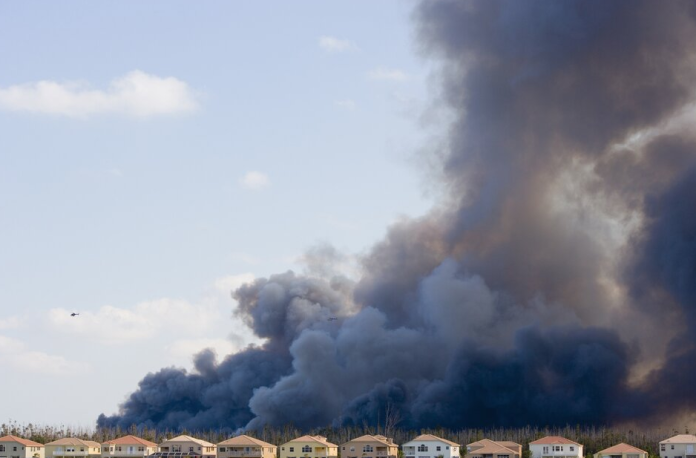According to the National Oceanic and Atmospheric Administration, there were 24 confirmed major weather – and climate-related disasters – in 2024 causing at least $1 billion in damages each (although losses for some events can reach into the tens of billions).
Of these 24 disasters, 17 were severe storms, four were hurricanes, two were winter storms and one was a wildfire, ultimately causing more than 400 deaths.
Nationally, in 2024 there were more than 1,700 tornadoes – more than any other year except 2011. Texas alone experienced three severe weather events, a hail storm and a hurricane in 2024.
The Southeast faced three major tropical storms, including two hurricanes (Helene and Milton) only two weeks apart, with Helene becoming the deadliest hurricane since Katrina in 2005.
Since 1980, according to the National Oceanic and Atmospheric Administration, the United States has experienced 400 “billion-dollar” weather-related disasters, which are becoming increasingly frequent. In 1980, there were 3.3 such disasters. That average rose to 13.1 in the 2010s. Between 2020 and 2024, the average continued rising to 22.5 per year, increasing nearly seven times in just over 40 years.
It’s also a global problem. According to a report by Climate Central, 72 countries with more than 25% of the world’s population collectively suffered through their hottest summer in 2024 in more than 50 years, and half the world’s population experienced unusually hot temperatures in June, July and August.
In the Northern Hemisphere, 180 cities reported at least one extreme heat wave of the summer, which was 21 times more likely due to climate change and which acts like a giant exclamation point to what otherwise would be much more modest events.
Just days into 2025, Los Angeles County is experiencing some of its most destructive wildfires in state history, created by what scientists have dubbed a “hydroclimate whiplash” owing to unusually wet winters in 2023 and 2024, which prompted the growth of brush and grass throughout the types of wildland urban interfaces common throughout Southern California.
Now, with the state back in drought-like conditions after multiple months with little rain, this dried-out fuel was primed to explode and spread given the strongest dry and warm Santa Ana-type winds since 2011.
Looking ahead, these types of weather-related whiplash events are expected to rise further as the climate continues to warm.
According to a new study from Nature Reviews Earth & Environment, hydroclimate whiplash events have risen 31% to 66% since the mid-1900s.
And it could double if the world blows past its goals from the 2015 Paris Agreement to keep global temperatures well below 2°C (3.6°F) above preindustrial levels.
Housing Market Impacts
As the consequences from climate change accelerate, they are also starting to impact housing values, and with no city or state completely safe from natural disasters, the clock is ticking everywhere.
Since these emerging threats continue to be ignored by many mortgage originators and investors (but certainly not insurance companies), it’s up to individual homebuyers to conduct their own research, ask the right questions and determine what level of risk they’re willing to assume in a warming world.
These alarming messages were front and center at the May 2024 “Going to Extremes” conference near the nation’s capital in National Harbor, Maryland. Organized and co-hosted by Toni Moss, CEO of AmeriCatalyst and an international expert on mortgage finance markets, the gathering of invited climate scientists, senior government housing officials, economists, insurance experts, data analysts and investors raised more questions than answers.
By the end of the conference, it became clear that until the country’s leaders in politics, business and finance step up a workable framework to deal with the threats to real property, it’s up to individual buyers, sellers and investors to conduct their own due diligence.
If there is truly a “climate housing bubble” in effect – artificially propping up housing values in the hardest-hit areas due to lack of sales and not factoring in the rising costs of homeownership aside from mortgage payments – it will pop when there are more choices for well-informed buyers or when entire neighborhoods, cities or even states become effectively uninsurable.
Since real estate agents risk lawsuits by providing data or advice on climate perils, it’s ultimately up to individual buyers to conduct their own research.
At the moment the only large housing market players reacting to the escalating costs of stronger storms, floods and wildfires are the property insurance companies.
When possible, they’re using the blunt instrument of steep premium hikes, or, when that’s not possible, such as in California, abandoning entire states until they’ve got a better handle on underwriting the future risks we all face.
The Risks We Face
For its part, the Federal Emergency Management Agency maintains a National Risk Index that includes 18 hazard types: avalanche, coastal flooding, cold wave, drought, earthquake, hail, heat wave, hurricane, ice storm, landslide, lightning, riverine flooding, strong wind, tornado, tsunami, volcanic activity, wildfire and winter weather.
For the purpose of analyzing the most prevalent hazard types in a warming world, the five most common across the country include:
- Drought: Behind hurricanes, droughts are the second-most costly weather events in America. And, unlike hurricanes, drought conditions can continue for months or even years, causing long-term damage.
- Heat: Since the 1960s, heatwaves have become significantly more frequent, more intense, longer and have occurred across a wider seasonal range. Statistics from the National Weather Service show that heat has been the most deadly extreme weather phenomenon in the U.S. over the last 30 years.
- Fire: There are more than 46 million residences in America located in wildland urban interface areas, which in many cases offer the most affordable housing due to their distance from major job centers. These are the transition zones where human development intermingles with undeveloped land and vegetative fuels. In 2022, 66,255 wildfires burned through more than 7.5 million acres.
- Storm: Nationally, tornadoes, hailstorms, hurricanes, derechos and tropical storms cause hundreds of millions or billions of dollars in property damage every year. Tornadoes cause the most fatalities out of any storm, and hurricanes cause the most severe property damage.
- Flood: Of all the weather-related natural disasters that occur, floods are the most common. FEMA’s website says that if you live in an area with low or moderate flood risk, you are five times more likely to experience a flood than a fire in your home over the next 30 years.
Where to Find Data on Climate Change Risks
Although the list of sources providing data on climate change risks and perils is growing, the following offer free information for specific addresses throughout the United States:
These sources should be used as a starting place, paired with more due diligence. For example, when it comes to flooding, according to the Natural Resources Defense Council, “more than one-third of states have no statutory or regulatory requirement that a seller must disclose a property’s flood risks or past flood damages to a potential buyer. The other states have varying degrees of disclosure requirements.” Even in states with more robust disclosure laws, because FEMA’s flood maps are often out of date or are ill-prepared to predict future floods in a warming climate, buyers might want to opt for flood insurance anyway.
Building Codes
In the years ahead, it’s likely that many homeowners, buyers and sellers will become closely acquainted with their local building codes because stricter codes can lead to homes that are more resilient to storms, use less energy and are safer than homes built under more permissive ones.
In 1994, a nonprofit standards organization called the International Code Council developed a series of model building codes including the International Residential Code, which has since been adopted by most U.S. jurisdictions.
Although these code standards are updated every three years – with the last update completed in 2021 – compliance is voluntary and often viewed by builders as too costly at a time when they’re already racing to build as many homes as possible.
Fortunately, there are free online tools to verify the building code adoption status for various levels of government, or for buyers interested in newly built homes available for sale, ask the builder for more details.
FEMA’s Building Code Adoption Tracking program, known as BCAT, “tracks the building code adoption status for state, local, tribal and territorial governments across the nation to evaluate several important aspects of a community’s natural hazard risks and building code adoption.”
Nationally, as of the second quarter of 2024, just 32% of jurisdictions tracked by BCAT have embraced the most current building codes resistant to damaging wind, hurricane wind, tornado, flood and seismic events. These resistance percentages range from 24% for tornadoes to 63% for hurricane winds.
However, there are some important caveats to consider for these data points. While the percentage focuses on the importance of adopting the most updated building codes, it does not mean that communities built to older codes are underprepared. Moreover, adopting a new code is meaningless without sufficient enforcement to ensure the most modern practices for new and existing structures. Consequently, it’s ultimately up to the buyer to confirm what building codes were actually being enforced when a home was built, renovated or remodeled.
The nonprofit Federal Alliance for Safe Homes, which is funded by a division of the U.S. Department of Homeland Security, provides a search tool for single-family homes, multifamily residences and commercial properties that will tell you if the local code is up to date, the community’s history of natural disasters, and the types of renovations, retrofits and upgrades most likely to increase the strength and safety of properties.
The Hurricane Coast
Since 2012, the Insurance Institute for Building and Home Safety has separately evaluated the 18 states along the Atlantic and Gulf coasts on residential building code adoption, enforcement, training, education and contractor licensing. Published every three years, the “Rating the States” report evaluates each of these 18 states on a 0–100 scale based on survey responses related to building code programs.
For the 2024 edition, Virginia, Florida and South Carolina were the three best-prepared states for storms including hurricanes, while the least-prepared states were led by Delaware, Alabama and fast-growing Texas.
During the 12-year period between 2012 and 2024, states improving the most on the “Rating the States” report were Mississippi (+40), Louisiana (+17) and Texas (+15), while those declining the most included Maine (-18) and Massachusetts (-10).
Real World Examples
To demonstrate how consumers might research both the building code status and the potential climate hazard ratings for specific areas, the following tables summarize key data points for the top five Hottest U.S. Housing Markets as well as the top five Best Places to Live in the U.S. in 2024-2025.
In the case of top-ranked Denver on our Hottest Housing Markets ranking, its building codes are up to date, which is good news considering hazard ratings of 76 for heat (very high), 69 for drought (very high), 14 for fire (potentially impacting 25% of buildings), 32 for floods (potentially impacting 14% of buildings) and 22 for precipitation/storms (significant).
For Naples, Florida, ranked first at the most recent Best Places to Live of the 150 major U.S. cities analyzed, its building codes are up to date, which is also good news considering hazard ratings of 96 for heat (extreme), 34 for drought (significant), 1 for fire (relatively low), 100 for floods (extreme) and 28 for precipitation/storms (significant).
How to Find a Climate-Savvy Real Estate Agent
Although the National Association of Realtors launched a Green Resource Council in 2008 to educate agents on sustainability for both existing and newly built homes and introduce a Green Designation to its members, that doesn’t mean green agents are also experts on the emerging perils of climate change.
According to Robert Schantz, vice president of coaching and a managing broker for several Keller Williams offices in the San Diego area, the best way to find an agent knowledgeable about climate change risks is the easiest: detailed interviews. “Ask them if they have any accreditations or what they have seen from their experience,” he advises. He recommends that buyers talk to insurance agents before starting house hunting so they’re aware of any insurance challenges in specific areas.
Once buyers are in escrow and various disclosures are being delivered, Schantz suggests agents go through them in detail while there’s still a chance to back out of an offer. “Unfortunately, most agents do not have an in-depth conversation as they should,” he says. “When I deliver risk management training to my agents, I discuss with them how important it is to have a serious conversation with their buyers during the escrow process.”
For real estate agents navigating a much more complicated landscape against the backdrop of climate change, Schantz also has advice: “If the agents do not take the time to get educated, it sometimes does not help the consumer to be fully informed. Don’t just say you are a real estate agent. Become educated so you can better assist your buyers and sellers.”
Questions Buyers Should Ask Sellers
Although many of the following questions would be answered during the disclosure process during escrow, ideally buyers should have the answers in place before submitting an offer:
- What is your current homeowner’s insurance premium, and who is the carrier?
- Is the home in a flood zone? If not, do you still carry flood insurance due to outdated maps?
- What types of climate risks have increased in recent years for this property? In what ways have you increased the property’s resilience for climate risks?
- What are the ages and conditions of the roofing, electrical, plumbing and heating/ventilation/air conditioning systems? Insurers are increasingly asking about these systems for homes over 25 years of age to minimize further losses.
How Sellers Can Prepare
If you’re hoping to receive reasonable offers for your listing, assume that the competition has already completed the following tasks, or be willing to offer a seller credit:
- Obtain detailed climate risk reports for your property.
- Conduct an energy and resilience audit.
- Adapt your home to increase resiliency to fire, heat, drought, floods, wind, hail and rain up to the latest building codes.
- If needed, update roofing, electrical, plumbing and HVAC systems.






















